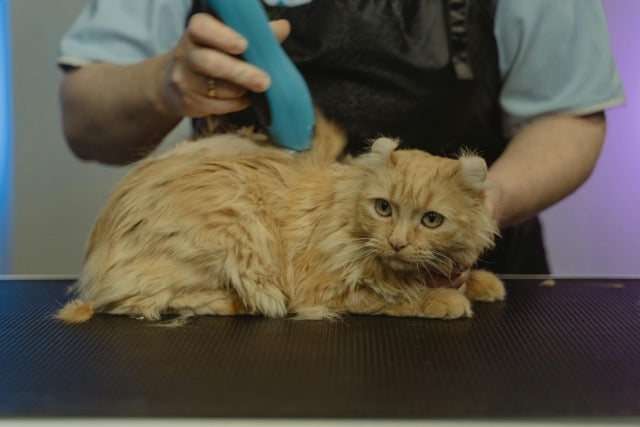Grooming a cat is not just about keeping them looking good—it's a crucial aspect of their overall health care. Regular grooming helps prevent matting, reduces hairballs, and is an excellent way to check for fleas and skin problems. Whether you're a new cat owner or looking to brush up on your grooming skills, this guide will provide detailed instructions on how to groom a cat effectively, covering brushing, bathing, nail trimming, ear cleaning, and more.
Understanding Cat Grooming
Grooming a cat can sometimes be challenging, as cats vary in their tolerance to different types of grooming. It's important to introduce grooming activities gradually and to be as gentle as possible.
The Importance of Grooming Your Cat
- Skin and Coat Health: Regular brushing removes dirt, grease, and dead hair from the coat, which helps to prevent matting and hairballs.
- Monitoring Health: Grooming sessions are a chance to check for bumps, lumps, parasites, and other abnormalities that might require veterinary attention.
- Bonding Time: Grooming can be a wonderful way to strengthen the bond between you and your cat.
Tools Needed for Cat Grooming
Before you start grooming your cat, make sure you have the right tools on hand. Here's what you'll need:
- Brushes and Combs: Depending on your cat's coat type, you may need a bristle brush, a fine-toothed comb, a rubber grooming brush, or a de-shedding tool.
- Cat Shampoo: Use a shampoo specifically formulated for cats.
- Nail Clippers: These should also be specifically designed for cats.
- Cotton Balls: For cleaning the ears.
- Soft Towels: For drying your cat after a bath.
- Ear Cleaner: A vet-approved ear cleaning solution.
- Toothbrush and Toothpaste: Use products designed specifically for cats.
Brushing Your Cat
Brushing is the most frequent grooming task and is vital for all cats, particularly those with long hair.
Short-haired Cats
- Frequency: Brush short-haired cats once a week.
- Tools: Use a fine-toothed comb or a rubber grooming brush.
- Method: Brush in the direction of hair growth to remove loose hair and debris.
Long-haired Cats
- Frequency: Brush long-haired cats daily.
- Tools: Use a wide-toothed comb followed by a fine-toothed comb.
- Method: Start with the undercoat, gently teasing out tangles, and then comb the outer coat.
Bathing Your Cat

Most cats generally keep themselves clean and may not need frequent baths, but occasional bathing can help reduce grease and minimize shedding.
- Preparation: Before bathing, thoroughly brush your cat to remove any tangles.
- Environment: Use a sink or a small tub, and fill it with about three to four inches of warm water.
- Bathing: Wet your cat gently with a spray hose or a pitcher. Apply cat shampoo and lather, avoiding the face, ears, and eyes. Rinse thoroughly.
- Drying: Wrap your cat in a soft towel and pat dry. Long-haired cats may require a hair dryer set on low heat, but only if the noise does not scare them.
Nail Trimming

Trimming your cat's nails is important to prevent them from becoming overgrown, which can lead to painful conditions.
- Handling: Get your cat used to having its paws handled by gently pressing on the pads to extend the nails.
- Cutting: Use a sharp cat nail clipper to cut the white part of each nail, avoiding the pink quick, which can bleed and cause pain.
Ear Cleaning

Cats' ears should also be checked and cleaned regularly, but only if there is visible dirt or wax.
- Checking: Look for signs of redness, odor, or excessive scratching.
- Cleaning: Apply a few drops of cat ear cleaner to each ear. Gently massage the base of the ears and then let your cat shake out the excess cleaner. Wipe away any loose debris with a cotton ball.
Dental Care
Dental health in cats is often overlooked but brushing their teeth can prevent many health issues.
- Frequency: Aim to brush your cat’s teeth several times a week.
- Method: Use a toothbrush and toothpaste formulated for cats. Introduce this slowly and be consistent.
FAQs About Grooming a Cat
Q: How often should I groom my cat? A: Brushing should be done at least once a week for short-haired cats and daily for long-haired cats. Bathing can be done monthly or as needed. Nail trimming should be done every 2-4 weeks.
Q: What should I do if my cat hates being groomed? A: Start slowly and with the most tolerable activities, like gentle brushing. Use treats and praise to create positive associations.
Q: Can I use human shampoo on my cat? A: No, always use a shampoo specifically formulated for cats, as human shampoo can be harsh on their skin.
Q: How do I trim a cat’s nails if they won’t let me? A: It may be necessary to have another person help by holding the cat, or in difficult cases, seek professional grooming services or veterinary assistance.
Q: What are some signs that my cat may need professional grooming? A: If your cat has severe matting, behavioral issues that make home grooming impossible, or if you are unable to keep up with regular grooming needs.
Regular grooming not only helps keep your cat looking good but also contributes to their physical health and emotional well-being. By incorporating these grooming routines into your schedule, you ensure that your feline friend stays healthy and happy.


